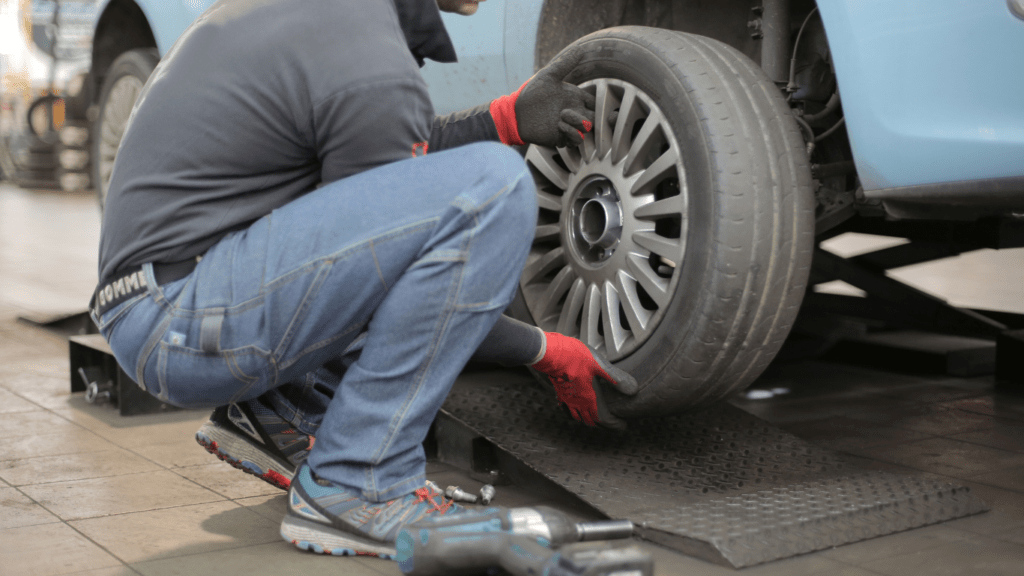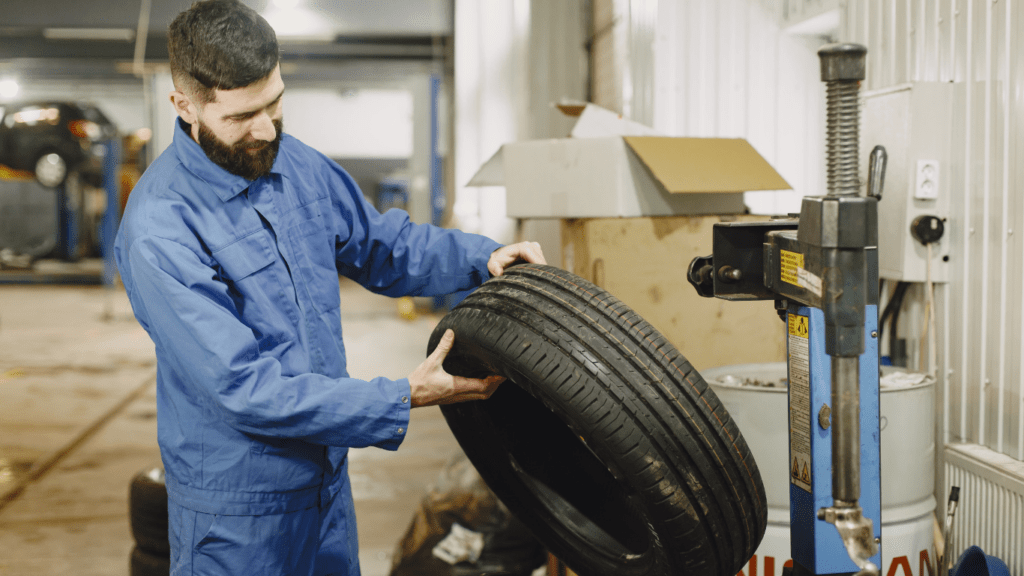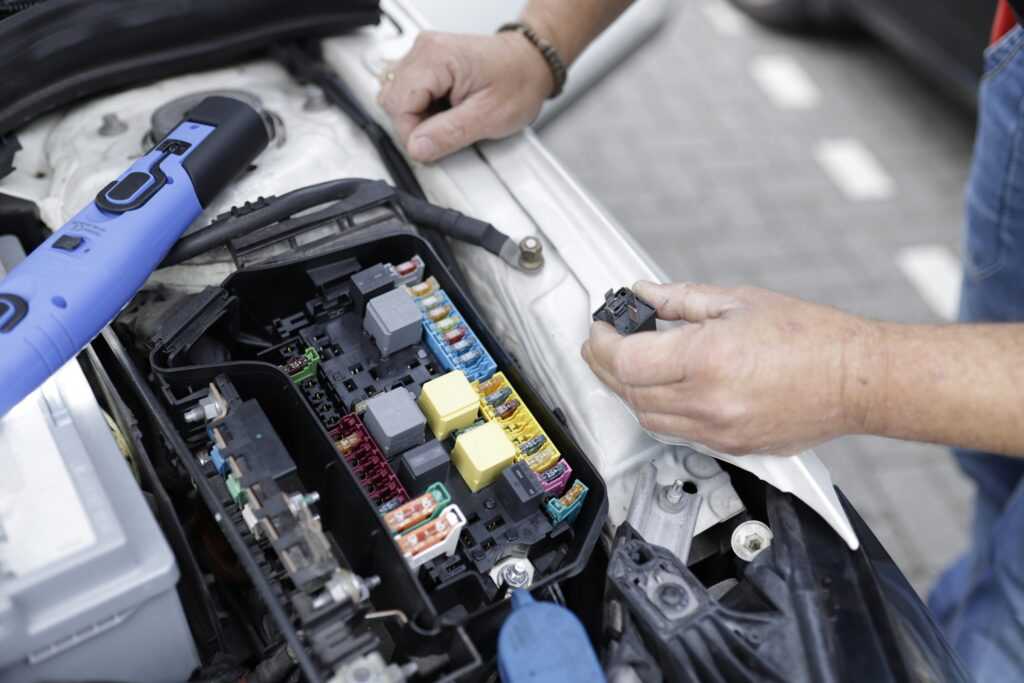Importance of Tire Maintenance
Tire maintenance significantly improves vehicle safety. Properly maintained tires offer better traction, handling, and braking performance. This reduces the risk of accidents, especially during adverse weather conditions like rain or snow.
Well-maintained tires enhance fuel efficiency. Under-inflated tires increase rolling resistance, which leads to higher fuel consumption. Keeping your tires inflated to the recommended pressure can save money on fuel in the long run.
Tire maintenance extends tire lifespan. Regular inspections can identify issues like uneven tread wear or embedded objects before they cause irreparable damage. Rotating and balancing tires also ensure even wear, maximizing their usable life.
Maintaining tires improves overall vehicle performance. Imbalanced or misaligned tires can cause vibrations and uneven handling, leading to a rough driving experience. Regular upkeep ensures your vehicle runs smoothly, providing a comfortable ride.
Proper tire care contributes to environmental sustainability. Longer-lasting tires reduce waste, and optimal fuel efficiency means fewer emissions. By maintaining your tires, you help protect the environment as well.
Tire maintenance encompasses vehicle safety, enhanced fuel efficiency, extended tire lifespan, improved performance, and environmental benefits. Ignoring this essential task could result in higher costs, frequent replacements, and potential safety hazards.
Regular Tire Inspections

Regular tire inspections play a crucial role in vehicle safety and performance. These checks help identify potential issues early, saving money and enhancing driving experience.
Visual Checks
Visual checks allow for quick identification of obvious problems. I examine each tire for cuts, cracks, or bulges. If the sidewalls show any deformities, I consider replacing the tire. I also look for uneven wear patterns, which might indicate alignment or suspension issues. By routinely checking for debris lodged in the tread, I reduce the risk of punctures and further damage.
Tread Depth Measurement
Tread depth measurement ensures that tires have sufficient grip. Using a tread depth gauge, I verify that the tread is at least 2/32 of an inch deep, which is the minimum legal limit in many states. If the tread is nearing this limit, I consider replacing the tires to maintain optimal traction and safety. I also use the “penny test” by inserting a penny into the tread with Lincoln’s head upside down; if I can see the top of Lincoln’s head, the tread is too worn. This simple test helps me ensure my tires are suitable for safe driving.
Maintaining Proper Tire Pressure
Proper tire pressure is crucial for tire maintenance. It ensures safety, extends tire lifespan, and enhances vehicle performance.
Recommended PSI Levels
Manufacturers provide recommended PSI (pounds per square inch) levels for each vehicle. These values are typically found in the vehicle’s owner manual or on a sticker inside the driver’s door. Sticking to these recommendations optimizes tire performance and fuel efficiency. For example, most passenger cars recommend PSI levels between 30 and 35. Overinflated tires may cause uneven wear, while underinflated tires increase rolling resistance and fuel consumption.
Checking Tire Pressure
Regular checking of tire pressure ensures tires remain within recommended PSI levels. I use a reliable tire pressure gauge, either digital or analog, to get accurate readings. Check tires when they are cold, as driving heats up tires and can give false readings. Remove the valve cap, press the gauge onto the valve stem, and note the PSI reading. Compare it to the manufacturer’s recommendation. If the pressure is low, inflate the tire to the correct level. If it’s high, release air until the pressure matches the recommended level. Monthly checks help identify slow leaks and maintain optimal performance.
Tire Rotation and Balancing
Regular rotation and balancing of your car’s tires are essential practices for tire maintenance. They ensure even wear, prolong tire life, and contribute to a smoother ride.
Importance of Tire Rotation
Rotating tires promotes even tread wear. I recommend rotating tires every 5,000 to 7,500 miles, depending on the vehicle’s manual. Even tread wear improves traction and handling. It also prevents premature tire replacement. Uneven wear often results from factors like weight distribution and driving habits. Rotating tires counteracts these effects.
Balancing Your Tires
Balancing tires eliminates vibrations and extends their lifespan. Imbalances occur from uneven weight distribution. I suggest balancing tires whenever you rotate them or if you notice vibrations. Proper balancing enhances ride quality. It also reduces strain on suspension components. Not balancing tires can cause uneven tread wear.
Aligning Your Wheels
Wheel alignment is crucial for tire longevity and vehicle performance. Misaligned wheels can lead to uneven tire wear and affect handling.
Signs of Misalignment
Recognize signs of poor alignment to maintain optimal tire health. Key indicators include:
- Uneven Tire Wear: Tires wearing unevenly or more on one side suggest alignment issues.
- Vehicle Pulling: If the vehicle pulls to one side when driving straight, the alignment might be off.
- Steering Wheel Vibration: A vibrating steering wheel, especially at higher speeds, can indicate misalignment.
- Off-center Steering Wheel: If the steering wheel isn’t centered when driving straight, alignment needs checking.
- Consult a Professional: Visit a reputable auto repair shop specializing in wheel alignment. They have the necessary equipment to measure and adjust alignment accurately.
- Regular Checks: Incorporate alignment checks into your routine vehicle maintenance. Mechanics typically recommend checking alignment every 10,000 miles or during every other oil change.
- Alignment Types: Understand that there are different types of alignment, such as front-end, thrust, and four-wheel alignment. Confirm with your mechanic which type your vehicle needs.
- Maintain Records: Keep a record of alignments and tire rotations. This helps track when the next service is due and ensures consistent vehicle performance.
Seasonal Tire Care
Maintaining your car’s tires through different seasons can significantly enhance their performance and lifespan. Let’s explore how to best care for tires in winter and summer, as well as the proper way to store off-season tires.
Winter vs. Summer Tires
Winter tires provide superior traction on snow and ice. They’re made from softer rubber compounds designed to stay flexible in cold temperatures, offering better grip. For snowy and icy conditions, maintaining proper tire pressure is crucial for optimal performance.
Summer tires, on the other hand, are crafted for warm conditions. They consist of harder rubber compounds that provide better handling and braking on dry and wet roads. These tires perform poorly in cold conditions, losing flexibility and traction. It’s essential to switch back to winter or all-season tires if temperatures drop consistently below 45°F (7°C).
Storing Off-Season Tires
Proper storage techniques ensure that off-season tires remain in good condition. Clean tires thoroughly to remove dirt and brake dust. Let them dry completely to prevent mold growth.
Find a cool, dry place to store your tires away from direct sunlight, which can degrade rubber. Stack tires on their sides or use a tire rack to avoid distorting their shape. If possible, store each tire in a dedicated bag to shield them from environmental factors. This keeps them fresh and ready for the next season.




